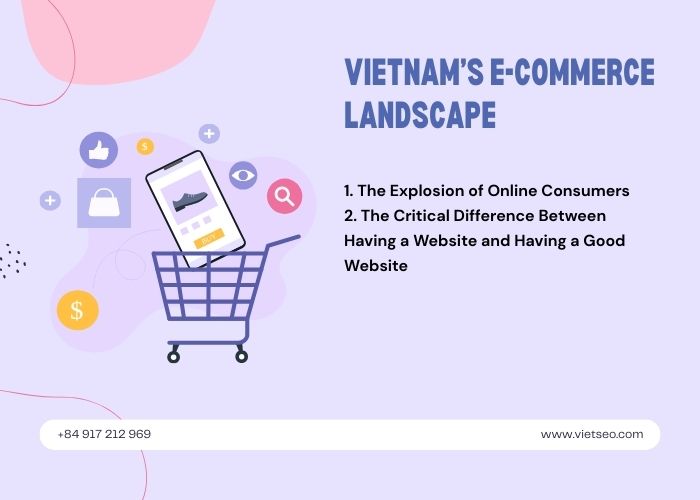Web Design: The Journey from Concept to User Experience
What Is Web Design? More Than Just Eye-Catching Interfaces
The concept of web design has evolved significantly over the past two decades. In the past, many believed that web design was simply about creating a page with neat layouts, harmonious colors, and complete information. But today, web design encompasses many more elements such as:
- Optimizing user experience (UX – User Experience)
- Designing user interfaces (UI – User Interface)
- Responsiveness across devices (Responsive Design)
- Page load speed
- Security
- Scalability and integration of new technologies
A successful website is a dynamic ecosystem where users feel served, guided, and inspired—both in content and presentation.
Start with a Clear Strategy: Understand the Objectives
Before drawing the first lines of a website, you need to answer a few fundamental questions:
- What is the website’s purpose? (brand introduction, sales, community building…)
- Who is the target audience?
- What actions do you want users to take? (purchase, fill out a form, register, share…)
- What design style fits your industry and company culture?
A clear design strategy will save you a lot of time and cost during development.
Information Architecture: The Backbone of Every Website
Information Architecture (IA) plays a key role in logically organizing content to ensure accessibility. A solid IA will:
- Help users easily find the information they need
- Increase time spent on site
- Improve conversion rates
Sitemaps and wireframes are common tools to draft IA before diving into the visual design stage.
UX/UI: Putting the User at the Center
UX – Creating an Emotional Experience
UX design is the art of arranging elements in an intuitive and logical way so users feel comfortable, convenient, and satisfied when using the site. Key UX principles include:
- Minimalism and clarity: Avoid overcrowding with unnecessary elements
- Logical user journey: Clear pathways from the homepage to key actions
- Good navigation: Menus and calls-to-action (CTAs) that are easy to see and use
UI – Creating a Visual Identity
UI is the "front" of your site: colors, fonts, images, icons, layout... Everything must be consistent, modern, and reflect your brand. A well-designed UI leaves a lasting impression and enhances your business's professionalism.
Modern Web Design Technologies and Tools
Popular platforms:
- WordPress: Easy to use, flexible, with many themes and plugins
- Webflow: For designers who want visual control without coding
- Wix, Shopify: Ideal for non-tech users to build websites quickly
- React, Next.js, Vue.js: For developers needing high performance and SPA
Supporting tools:
- Figma, Adobe XD, Sketch: For UI/UX design
- Google PageSpeed Insights, GTMetrix: For speed evaluation
- Hotjar, Crazy Egg: For user behavior analysis
Mobile Responsiveness and Responsive Design
With over 60% of website traffic coming from mobile devices, optimizing display for smartphones and tablets is essential. Responsive design allows the site to adjust layout based on screen size, ensuring consistent user experience.
Optimizing Load Speed: A Critical Factor
Page speed directly affects user experience and search rankings. A slow-loading website can drive users away in seconds. Ways to optimize include:
- Compressing images
- Using a CDN (Content Delivery Network)
- Optimizing code, CSS, JS
- Using high-quality hosting
Website Security: Not Just for E-Commerce Sites
All websites are vulnerable to attacks—from spam to data theft. Essential security measures include:
- HTTPS protocol
- Regular updates of plugins and CMS
- Setting up firewalls
- Regular data backups
- Limiting admin access rights
Technical SEO and Google-Friendly Design
SEO-friendly design isn't just about keyword placement. It's about building a well-structured site with fast loading, easy navigation, and useful content. Key technical elements:
- Heading tags (H1, H2…)
- XML Sitemap and Robots.txt
- Schema Markup
- Proper Meta Descriptions and Titles
Web Design Trends for 2025
Web design constantly evolves with market demands and user tastes. Prominent trends in 2025 include:
- Minimal yet dynamic designs: With micro-interactions
- Dark mode: Saves battery, reduces eye strain
- AI integration: Chatbots, smart search, product recommendations
- No-code/low-code platforms: Empower businesses to build websites fast
- Mobile app-inspired design: App-style UI, swipe gestures, sliders
Web Design for Small Businesses: Balancing Cost and Effectiveness
You don’t need to invest hundreds of millions (VND) to own a professional website. Small businesses can still thrive online by choosing the right tools and focusing on:
- Clarity and usability
- Easy-to-find contact information
- Clear conversion goals
- Valuable content over flashy visuals
After Launching a Website: How to Maximize Its Potential
- Regularly update content
- Run online marketing campaigns (Google Ads, SEO, Facebook…)
- Analyze user behavior via Google Analytics
- Continuously improve based on real-world feedback
A website is not just a destination, but a place to connect, interact, and nurture long-term relationships with customers.
Website – More Than Just Information, It's an Experience
Web design is no longer just about pretty images or neat layouts. It's a blend of user-centered thinking, technological agility, and sustainable strategy. In the digital era, a great website not only brings in customers but is also one of the most valuable intangible assets a brand can have.
Whether you're a startup or an established brand, investing seriously in web design is how you tell your brand's story, convince, and connect with users—click by click.



